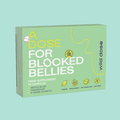How To Stop Endometriosis Bloating?
Endometriosis is a women’s health condition that impacts around 10% of reproductive-age females (equating to around 190 million people). The severity of endometriosis can vary from person to person and depends largely on the steps that are taken to manage it.
Sadly, there is no cure for endometriosis, and it’s for this reason that treatment generally focuses on managing symptoms and improving the individual’s quality of life.
Whether you have endometriosis or you know somebody who has been diagnosed with this condition, it’s great to educate yourself about its symptoms, causes, and treatment options. Luckily, you’re already in the process of learning more about endometriosis because you’re here, reading this article!
In this article, we will cover everything you need to know about endometriosis. We will include details on what it is, what its most common symptoms are, why it causes bloating, and how to effectively manage endometriosis and hormone-related bloating.
What Is Endometriosis?
Endometriosis is a condition that occurs when endometrial tissue (the type of tissue that lines the uterus) grows outside of the uterus. Usually, this tissue grows on the ovaries and cervix.
When endometrial tissue grows in areas where it shouldn’t, it can cause a host of complications. The most common symptoms of endometriosis include:
- Severe pain in the lower abdomen and pelvis
- Excessive bloating and nausea
- Pain during sex
- Pain when going to the toilet
- Heavy bleeding during menstruation or between periods
- Chronic fatigue
Some women may also experience difficulty getting pregnant, secondary to their endometriosis. However, endometriosis does not cause permanent infertility, and you can absolutely get pregnant with endometriosis if this is your goal!
The Stages of Endometriosis
Medically, endometriosis is split into stages, ranging from minimal symptoms to severe symptoms, as follows:
- Stage I (minimal) - if you have just a few small lesions but no scar tissue, you'll be diagnosed with stage I endometriosis.
- Stage II (mild) - If you have quite a few lesions but still no scar tissue and there is less than 2% of your abdomen contains endometrial tissue, then you're experiencing mild stage II endometriosis.
- Stage II (moderate). If the lesions in your abdomen are deep and you have some endometriomas or scar tissue around your ovaries or fallopian tubes, your stage II endometriosis is classed as moderate in severity.
- Stage IV (severe). When you have many lesions, the presence of large cysts on your ovaries, and scar tissue around your ovaries and fallopian tubes or between your uterus and the lower part of your intestines, you may receive a stage IV endometriosis diagnosis.
The stages of endometriosis don’t take pain or symptoms into account. They are purely based on clinical presentation. An individual who has stage I endometriosis might experience severe pain and bloating, and a woman with stage IV endometriosis might experience very few symptoms.
What Causes Endometriosis?
Endometriosis has a number of different causes, and some of the most common include:
1. Retrograde menstruation
Retrograde menstruation is a fancy way of saying 'backflow of menstrual blood'. This occurs when menstrual blood that contains endometrial cells flows back through the fallopian tubes and into the pelvic cavity instead of out of the body like it should during a normal period.
These endometrial cells stick to the pelvic walls and the surfaces of the pelvic organs. Here, they grow and thicken and shed during the course of each menstrual cycle.
2. Surgical scars
Scars may form after pelvic surgery, such as a hysterectomy or cesarean section, and endometrial tissue can stick to these scars and cause future symptoms.
3. Endometrial cell transport
Sometimes, blood vessels and lymphatic vessels can pick up cells from the endometrium and transport them outside the uterus, where they implant.
4. Immune issues
It's also been proposed that problems with the immune system can cause endometriosis. If the body's immune cells are unable to recognise endometrial cells outside the uterus, they might respond by attacking this tissue and causing severe pain. This theory came about due to the high correlation between autoimmune conditions and endometriosis.
5. Genetics
There is also thought to be a genetic component to endometriosis, as you're more likely to experience it if your mum or sister also suffers from the condition.
6. Dietary component
Some studies suggest that those with gluten intolerance are more likely to experience endometriosis. Many people report significant improvements in their endo belly and associated symptoms when they remove gluten from their diet. Whether this is due to the removal of the gluten protein or the fructan carbohydrates that are found in gluten-containing foods is unknown.
High consumption of B vitamins, vitamin D, omega-3s, and fibre can decrease the risk and severity of endometriosis.
The Diagnosis of Endometriosis
Because of the above symptoms, endometriosis is often mistaken for dysmenorrhea (period cramps), pelvic inflammatory disease, or irritable bowel syndrome (IBS). However, with thorough diagnostic testing, doctors can rule out these conditions and hone in on an endometriosis diagnosis.
The diagnostic methods that doctors can use to confirm endometriosis include:
- A physical examination of the pelvis to check for cysts or scars on the uterus and surrounding tissues.
- Diagnostic imaging, including ultrasound scans, CT scans, and MRI scans.
- Laparoscopy, which is a procedure where a doctor makes a small cut in your belly and inserts a thin tube with a camera on the end (laparoscope) to view lesions. This is usually the only way to be totally certain that you have endometriosis.
- Endometrial biopsy, where a doctor takes a sample of tissue (often taken during a laparoscopy procedure), and a specialist views it under a microscope to confirm the diagnosis of endometriosis.
Many women walk around with endometriosis for several years without getting their symptoms checked out. We blame this on the fact that painful periods and major pre-menstrual syndrome (PMS) symptoms have become normalised in today’s society. Most women think that they simply need to deal with their painful periods and get on with their lives, but this isn’t the case.
If you’re experiencing painful, debilitating periods or very heavy menstrual bleeding, you might have endometriosis, hormonal imbalances, or another reproductive condition. It’s important to get yourself to the doctor’s office and request ultrasound scans and blood tests to identify if there is an underlying problem that you need to address.
Often, the symptoms of endometriosis arise due to the inflammation and pelvic scarring that it causes. This inflammation leads to abdominal swelling and bloating. Keep reading to learn more about the connection between endometriosis and bloating.
What Causes Endometriosis Bloating?
Endometrial bloating is sometimes referred to as ‘endo belly‘. Although rarely spoken about, abdominal bloating can cause women a lot of distress, and it can be uncomfortable or even painful at times.
Endometrial tissue that grows outside of the endometrium acts exactly the same as it would if it were inside the uterus. This means that when prostaglandins are released during your period to cause the uterine lining to shreds, the endometrial tissue outside of the uterus also shreds.
In other words, endometrial tissue on the ovaries or pelvic structures builds and breaks down each month according to your reproductive hormones. The breakdown of this tissue causes severe pain because it doesn’t have anywhere to go. Unlike the endometrial tissue in the uterus that can leave the body through the cervix, pelvic endometrial tissue can’t escape.
As a result, the tissue builds up and forms scars on the pelvis. These scars can become inflamed and irritated, particularly around menstruation when inflammatory molecules are at their highest concentrations. This scarring causes inflammation, water retention, and bloating (endo belly).
One study performed quite a few years back (but we still think it is still very relevant) showed that 96% of women with endometriosis experience abdominal bloating, compared to just 64% of women without endometriosis.
Endometriosis can cause belly bloating due to a number of different reasons, including:
- The build-up of endometrial tissue in the pelvis, which causes water retention and bloating.
- Trapped blood inside pelvic cysts.
- Increased risk of small intestinal bacterial overgrowth (SIBO) and uterine fibroids that can increase water retention and belly bloating.
- Increased risk of digestion issues, such as gas and constipation.
Signs of Endometriosis Bloating
The main symptom of endometriosis-related bloating is abdominal swelling that occurs around menstruation (a woman’s period). When the abdomen fills with fluid and air, it can become swollen, inflamed, and sore.
Endo belly causes pressure on the lower abdominal organs, causing discomfort. It can last for just a few days before menstruation or may be ongoing for several weeks.
Many people say that they feel like they look pregnant when they have endo belly. The stomach becomes large, round, and hard to touch like it would during pregnancy!
Additional symptoms that women may experience alongside endometriosis bloating include gas pain, nausea, constipation, and diarrhoea.
How Can I Prevent Endometriosis Bloating?
As we mentioned, there is no cure for endometriosis, but you don’t have to suffer in silence. Below, we’ve got some of the best bloating remedies to relieve endo belly and other endometriosis symptoms.
1. Positive lifestyle changes
Making positive lifestyle changes can reduce bloating and abdominal pain. The best changes you can make are:
- Taking warm baths to soothe your stomach if it’s painful or swollen.
- Exercising regularly to lower psychological stress and promote the release of endorphins, which are the body’s natural painkillers.
- Practising yoga and stretching regularly to reduce stress and pain.
- Meditating to reduce stress.
2. Healthy dietary changes
Eating a healthy diet that is high in vitamins, minerals, healthy fats, and fibre, has been shown to reduce endometriosis symptom severity and ease bloating. This includes fruits, vegetables, oily fish, whole grains, beans, and legumes.
Garlic, ginger, and turmeric are great spices to add to your meals to reduce digestive discomfort, as they have natural anti-inflammatory properties that can minimise abdominal bloating and cramping around your period.
You should also avoid inflammatory foods and drinks, such as red meat, gluten, dairy, caffeine, and alcohol, to prevent aggravation of the endometrial tissue.
3. Digestive enzymes and probiotics
Digestive enzymes include amylase, lipases, and proteases. Your body produces them naturally but taking a supplement can aid your normal digestive processes.
Probiotics are live bacterial species, such as Bifidobacterium and Lactobacillus, that perform essential functions in your colon and promote great digestion. They have co-evolved alongside humans and are found in abundance in a healthy gut.
Probiotics can stop bloating and provide endo belly relief. These beneficial bacteria help to metabolise the food you eat and keep it moving swiftly through the digestion tract, reducing the risk of constipation and bloating.
You can find probiotics in fermented foods, such as sauerkraut, yoghurt, miso, kefir, tofu, and tempeh. You can also take probiotic supplements to support the gut bugs that already exist in your large intestines. Make sure that any supplement you take contains at least one billion colony-forming units (CFUs) of probiotic bacterial strains.
4. Pain-relieving medications
If you’re experiencing severe pain, you can take painkillers to ease your symptoms. However, they aren’t a long-term solution, and you should always consult a healthcare professional when making any sort of changes to your medications.
5. Hormone therapies
Some women choose to undergo hormone therapy to balance their reproductive hormone levels (in particular, oestrogen) to reduce bloating, inflammation, and scarring.
6. Surgeries
In severe cases, surgery might be necessary to remove some of the endometrial tissue that has found its way into the pelvic cavity. Surgeons can remove any cysts that are present in the ovaries or fallopian tubes too.
Removal of endometrial cells and cysts around the uterus can help to reduce bloating and abdominal discomfort in the long term.









